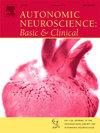骶神经调节治疗低尿路功能障碍:综述和作用机制
IF 3.3
4区 医学
Q2 NEUROSCIENCES
引用次数: 0
摘要
目的骶神经调节(SNM)自20世纪90年代以来广泛应用于膀胱过动症(OAB)和非梗阻性尿潴留(NOUR)的治疗,取得了良好的临床效果。然而,其作用机制尚未完全阐明。材料与方法本文旨在探讨SNM中作用机制的各种假设,并在现有文献的基础上提出一个作用的理论模型。结果snm可能主要通过骨盆底肌的亚感觉激活来调节传入信号,而骨盆底肌的亚感觉激活可能产生经脊髓传递到棘上结构的传入输入,而不是通过直接的传入神经刺激来调节传入信号。SNM可能通过减少前扣带皮层的活动和增加正中前额皮质的活动来恢复交感神经系统(SNS)和副交感神经系统(PSNS)之间的平衡。SNM也可能调节边缘系统(扣带皮层、脑岛)的活动,这与情绪有关,在Fowler综合征(一种特殊的NOUR实体)和OAB患者中经常失调。在NOUR中,SNM可能通过减少过度抑制性传入信息来恢复导水管周围的灰色活动,特别是通过改变正中前额皮质的活动。最后,骶神经调节(SNM)可能影响周围、脊柱和/或脊柱上水平的神经可塑性;然而,潜在的机制和特定的神经生理变化仍然不完全清楚。虽然我们对SNM作用机制的理解仍在不断发展,但新出现的数据指向一个涉及外周传入输入、脊髓加工和棘上结构(包括那些涉及感觉运动整合、情绪调节和自主神经平衡的结构)调节的多方面过程。本文章由计算机程序翻译,如有差异,请以英文原文为准。
Sacral neuromodulation for low urinary tract dysfunction: overview and mechanisms of action
Objectives
Sacral neuromodulation (SNM) is widely used since the 1990's for overactive bladder (OAB) and non-obstructive urinary retention (NOUR) with good clinical results. Though, its mechanisms of action are not fully elucidated.
Materials and methods
This narrative review intends to explore the various hypotheses of mechanisms of action in SNM, and to propose a theoretical model of action based on the current literature.
Results
SNM may modulate afferent signaling primarily through sub-sensory activation of pelvic floor muscles, which in turn may generate afferent input transmitted via the spinal cord to supraspinal structures, rather than through direct afferent neural stimulation. SNM may restore the balance between the sympathetic nervous system (SNS) and parasympathetic nervous system (PSNS) by decreasing activity in the anterior cingulate cortex and increasing activity in the median prefrontal cortex. SNM may also modulate the activity of the limbic system (cingulate cortex, insula), that is related to emotions and is frequently dysregulated in Fowler's syndrome – a specific NOUR entity, and patients with OAB. In NOUR, SNM may restore the periaqueductal gray activity through a diminution of excessive inhibitory afferent messages, particularly through modification of the activity of the median prefrontal cortex. Finally, sacral neuromodulation (SNM) may influence neural plasticity at the peripheral, spinal, and/or supraspinal levels; however, the underlying mechanisms and specific neurophysiological changes remain incompletely understood.
Conclusion
While our understanding of the mechanisms of action of SNM is still evolving, emerging data point toward a multifaceted process involving modulation of peripheral afferent input, spinal processing, and supraspinal structures - including those involved in sensorimotor integration, emotional regulation, and autonomic balance.
求助全文
通过发布文献求助,成功后即可免费获取论文全文。
去求助
来源期刊
CiteScore
5.80
自引率
7.40%
发文量
83
审稿时长
66 days
期刊介绍:
This is an international journal with broad coverage of all aspects of the autonomic nervous system in man and animals. The main areas of interest include the innervation of blood vessels and viscera, autonomic ganglia, efferent and afferent autonomic pathways, and autonomic nuclei and pathways in the central nervous system.
The Editors will consider papers that deal with any aspect of the autonomic nervous system, including structure, physiology, pharmacology, biochemistry, development, evolution, ageing, behavioural aspects, integrative role and influence on emotional and physical states of the body. Interdisciplinary studies will be encouraged. Studies dealing with human pathology will be also welcome.

 求助内容:
求助内容: 应助结果提醒方式:
应助结果提醒方式:


